

Biodiversity
Action
Plan
Upland birds. Several priority species of bird breed in the upland areas of Barnsley, the moors or moorland fringe; they utilise the blanket bog, upland heath or pastures there. The Peak District Moors (South Pennine Moors Phase 1) has been classified as a Special Protection Area (SPA) for its bird species. However drainage, overgrazing and agricultural improvement have reduced the upland breeding opportunities and climate change is another threat.
Dunlin and Golden Plover still breed on the blanket bog and heather moors as do Short-eared Owl and Merlin. Ring Ouzel breeds in the steep-sided rocky cloughs and Nightjar and Whinchat can also be occasionally found. Curlew frequent the moorland pastures. Some moorland is managed for Red Grouse.
Curlew, a large mottled brown-grey wader, has a long curved down beak, distinctive carrying call and white wedged rump visible in flight.
Curlews come to Barnsley in April to breed on moors and upland pastures, some in lower areas.
Curlews feed in rough damp pasture. Adults use their long bills to probe for worms, leather-jackets and other invertebrates.
Conservation measures
- Maintain rough, damp grassland; restrict drainage
- Control grazing to give taller vegetation for nesting cover
- Provide damp areas etc for chick feeding
- Avoid disturbance during breeding: mid-April- July.
RSPB advice
Associated Habitats
- Rough wet grassland including Rush Psture
Curlews nest in rough grassland, with some tall vegetation, scattered tussocks and rush patches, and damp areas.
They usually have one brood, with a second if the first one fails. Young birds fledge in late June or July. Chicks feed on surface insects and spiders.
Drainage, pasture ‘improvement’, tree planting, disturbance and predation cause declines.
Curlew
UKBAP 2007 Priority Species
NERC Section 41 Species
BoCC5 Red List [IUCN2 EN]
General protection W&C Act
Red Grouse is found on the Barnsley heather moors.
It is often spotted when disturbed, suddenly flying upwards ,with whirring wing-beats and distinctive call.
It feeds on shoots, seeds and flowers of heather, and also on berries and sometimes insects.
Males establish territories in the autumn; breeding is from April with one brood. Grouse shooting is from August 12 to Dec 10.
Conservation measures
- Maintain extensive areas of heather dominated moorland
- Maintain a range of younger to mature heather
- Eliminate over-grazing by sheep.
Associated Habitats
- Moorland with abundant heather - Upland Heath.
Although Barnsley moors managed for grouse shooting have artificially high numbers other moorland suffers from over-grazing and reversion to grass with fewer grouse.
Their decline is also caused by disease and predation.
Ring Ouzel, like a blackbird with a striking white breast band, is a scarce, localised breeding bird in Barnsley at less than ten pairs.
It breeds in the steep-sided rocky cloughs of heather moorlands and may forage in pastures of the moorland fringe and bracken and grassy areas.
It feeds on invertebrates such as worms, leather-jackets, etc and on berries in late summer.
Conservation measures
- Maintain a mosaic of heather and grass in breeding areas
- Protect nesting areas from overgrazing and burning.
- Protect from disturbance
- Avoid intensive tree planting near nesting / feeding areas.
RSPB conservation advice
Associated Habitats
Cloughs in heather moorland
Non-modified grassland
Arriving late March to early April, departing by September, Ring Ouzel breeds from mid April to July, with two broods common.
It nests on rock ledges, in a crevice hidden by vegetation or close to the ground in heather.
Loss and deterioration of nesting and foraging habitat, less invertebrate food and disturbance .may contribute to its decline in numbers.
Ring Ouzel
UKBAP 2007 Priority Species
NERC Section 41 Species
BoCC5 Red List [IUCN2 NT]
General protection W&C Act

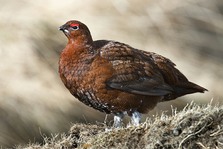
Nightjar, nocturnal and well-camouflaged, but seen hawking for moths and beetles. at dusk and dawn when the male’s 'churring' call can be heard.
In Barnsley Nightjar is a scarce, localised breeding bird, with up to six breeding pairs found in limited areas along moorland edge where there is heath and scattered or recently felled trees.
Whinchat, streaky brown above and orange-buff on its breast, it has a prominent white stripe above the eye.
It perches on top of bushes, making a clicking call. It feeds on insects and some seeds.
It is a very scarce, localised, summer migrant breeding bird in Barnsley, with between two and six pairs..
It breeds from March-June with one brood. Its nest is built low down in grass or bracken, made from moss and grass and lined with hair.
The loss of or detrimental changes to its habitat may be factors in its decline.
Conservation
- Heathland restoration and control of scrub
- Areas of mature heather with small gaps retained with a sparse trees.
- Avoidance of disturbance.
RSPB conservation advice
Associated Habitats
- Heathland
- Recently felled plantations.
Nightjar
UKBAP 2007 Priority Species
NERC Section 41 Species
BoCC5 Amber List
General Protection W&C Act
Conservation
- Maintain habitat quality of breeding sites.
- Retain varied vegetation structure eg scrub and bracken as well as shorter grass, near breeding sites.
Habitats
- Moors and heathland
- Rough grassland /bracken
Nightjars arrive in May and leave in late July and August and breed between June and July with one or perhaps two broods.
The nest is a shallow scrape in small gaps in deep heather or in low scrub.
Breeding habitat deterioration or loss, predation, decline in moths and other insect prey, could affect Nightjar numbers.
Whinchat
BoCC5 Red List [IUCN2 NT]
General protection W&C Act
Other upland birds include
Amber: Snipe (see waders); Meadow Pipit,
Green: Peregrine, Wheatear
UKBAP/S41 red listed priority species: Black Grouse, Hen Harrier and Twite, are found in areas nearby.
Cuckoo uses Meadow Pipit nests to lay its eggs in upland areas.
Conservation
- Rewetting blanket bog to support cranefly food
- Maintaining damp pastures
- Protecting breeding sites and foraging fields
Habitats
- Blanket Bog and Upland heath
- Damp grassland
They are found in moorland breeding areas from May to September.
They nest on the ground amongst heather or grass, preferring open ground so they can avoid predators.
Threats include a lack of cranefly food due to drying out of blanket bog and impact of climate changes.
Golden Plover with its gold and black summer plumage breed in small numbers on the blanket bog moors of Barnsley at the southern limit of their Pennine breeding range.
They are also found in winter flocks in lowland areas.
They feed on worms, beetles and insects espec. cranefly.
Golden Plover
BoCC5 Green List SPA
General protection W&C Act
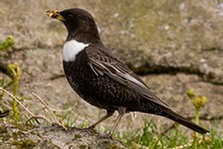
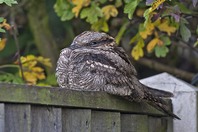
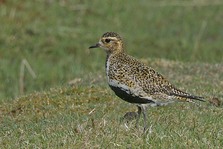
Upland birds
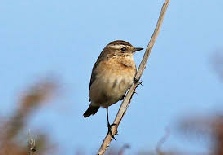
Merlin, and Short-eared Owl are also breeding birds for which the Peak District Moors (South Pennine Moors Phase 1) has been classified as a Special Protection Area (SPA). See Birds of Prey for information on these local priority species
Conservation
- Rewetting blanket bog to support cranefly food
- Protecting breeding sites and foraging areas
Habitats
- Blanket Bog
They vi ft their breeding areas from April to July.
They feed on invertebrates in moist boggy ground with pools and cotton grass vegetation.
They nest n shallow scrapes lined with plant material in low vegetation.
Threats include a lack of cranefly food due to drying out of blanket bog and impact of climate changes.
Dunlin, rusty-brown and white with a black belly patch, has been put on the BoCC Red list again in 2021 because of its decline,
It breeds in very small numbers on our top blanket bog moors, at the southern limit of its Pennine breeding range in Barnsley
A wader, in the winter they are found in large numbers at coastal mudflats.
Dunlin
BoCC5 Red List [IUNC2 VU] SPA
General protection W&C Act
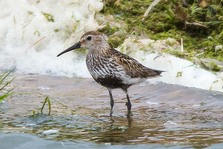
Red Grouse
UKBAP 2007 Priority Species
NERC Section 41
BoCC5 Green List
Game Bird Act
General protection W&C Act